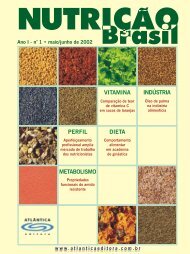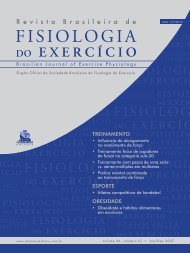Fisiologia do Exercicio_2005.pdf - Jean Peres
Fisiologia do Exercicio_2005.pdf - Jean Peres
Fisiologia do Exercicio_2005.pdf - Jean Peres
Create successful ePaper yourself
Turn your PDF publications into a flip-book with our unique Google optimized e-Paper software.
Revista Brasileira de <strong>Fisiologia</strong> <strong>do</strong> Exercício - Volume 4 Número 1 - janeiro/dezembro 2005<br />
Revisão<br />
Hipertensão arterial: uma abordagem direcionada aos<br />
efeitos <strong>do</strong> treinamento, mecanismos hipotensivos e<br />
respostas a programas de exercícios<br />
Arterial hypertension: effects of physical training, hypotensive<br />
mechanisms and applicability of exercise programs<br />
Kalline Russo*, Walace Monteiro**<br />
*Laboratório de Atividade Física e Promoção da Saúde - Universidade <strong>do</strong> Esta<strong>do</strong> <strong>do</strong> Rio de Janeiro (LABSAU/UERJ), **Laboratório<br />
de Atividade Física e Promoção da Saúde - Universidade <strong>do</strong> Esta<strong>do</strong> <strong>do</strong> Rio de Janeiro (LABSAU/UERJ), Programa de Pós-graduação<br />
em Ciências da Atividade Física - Universidade Salga<strong>do</strong> de Oliveira (UNIVERSO)<br />
Resumo<br />
A Hipertensão Arterial (HA) é uma condição multifatorial,<br />
associada a uma pressão arterial (PA) maior ou igual a 140/90<br />
mmHg ou ao uso de medicamentos anti-hipertensivos. No Brasil,<br />
estu<strong>do</strong>s epidemiológicos estimam uma prevalência da HA em<br />
torno de 40% da população adulta com mais de 40 anos. Uma das<br />
principais formas de prevenção e tratamento da HA consiste nas<br />
modifi cações <strong>do</strong> estilo de vida. Dentre as modifi cações, destaca-se<br />
a prática regular de atividade física. Desta forma, os objetivos <strong>do</strong><br />
presente artigo são: a) revisar os efeitos <strong>do</strong> treinamento físico na<br />
PA; b) apresentar os potenciais mecanismos hipotensivos como<br />
resposta ao exercício; c) apresentar e discutir as diferentes estratégias<br />
de atividades físicas envolven<strong>do</strong> programas formais e não formais de<br />
prescrição de exercício. O primeiro objetivo aborda os efeitos agu<strong>do</strong>s<br />
e crônicos das diferentes formas de treinamento (aeróbio, de força<br />
e fl exibilidade), assim como a infl uência das diferentes variáveis de<br />
prescrição nas respostas da PA. O segun<strong>do</strong> objetivo apresenta os<br />
principais mecanismos neuro-humorais e estruturais que tentam<br />
explicar a hipotensão como resposta à prática <strong>do</strong> exercício. Quanto<br />
ao enfoque <strong>do</strong> terceiro objetivo, são discutidas a aplicabilidade,<br />
vantagens e desvantagens de programas formais e não-formais de<br />
prescrição de exercícios.<br />
Palavras-chave: hipertensão, exercício, hipotensão, fisiologia<br />
cardiovascular, atividade física.<br />
49<br />
Abstract<br />
Th e arterial hypertension (HA) is a multifactorial condition<br />
associated with blood pressure (BP) equal or higher than 140/90<br />
mmHg or with the anti-hypertensive drugs. Epidemiological data<br />
estimate that 40% of the Brazilian adult population are older than<br />
40 yrs. One of the alternative interventions to prevent and treat<br />
HA is the regular physical activity. Th us the purposes of the present<br />
paper are: a) to review the eff ects of physical training on the<br />
HA; b) to describe the main hypotensive mechanisms associated<br />
with the exercise; c) to present and discuss the diff erent strategies<br />
to prescribe physical activities for hypertensive subjects, especially<br />
supervised and non-supervised programs. Th e fi rst objective focuses<br />
the acute and chronic eff ects of diff erent training programs (aerobic,<br />
strength and fl exibility), as well the infl uence of the manipulation<br />
of diff erent prescription variables on BP responses. Th e second<br />
purpose presents the neuro-humoral mechanisms that explain the<br />
hypotension as consequence of regular exercise. Th e third purpose<br />
discusses the applicability, advantages and limitations of supervised<br />
and non-supervised exercise programs.<br />
Key-words: hypertension, exercise, hypotension, cardiovascular<br />
physiology, physical activity.<br />
Recebi<strong>do</strong> 20 de outubro de 2005; aceito 25 de novembro de 2005.<br />
Endereço para correspondência: Walace Monteiro, Laboratório de Atividade Física e Promoção da Saúde, Universidade <strong>do</strong> Esta<strong>do</strong> <strong>do</strong><br />
Rio de Janeiro (LABSAU/UERJ), Rua São Francisco Xavier, 524, 8º andar, sala 8133, Bloco F. Maracanã, 20599-900 Rio de Janeiro RJ,<br />
E-mail: wdm@uerj.br





